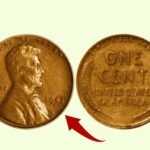Imagine fishing a penny out of your pocket, flipping it over, and realizing it’s worth $121 million. Sounds like a fairy tale, right? But the Lincoln Wheat Penny, a humble coin first minted over a century ago, has sparked wild dreams among coin collectors and everyday folks alike.
Rumors of a $121 million penny still circulating have set the internet ablaze, but is there truth to this jaw-dropping claim? Let’s dive into the history, value, and mystery of the Lincoln Wheat Penny—and explore whether you might have a fortune hiding in your change jar.
What Is the Lincoln Wheat Penny?
The Lincoln Wheat Penny, often called the “Wheat Penny,” is a one-cent coin minted by the U.S. Mint from 1909 to 1958. Designed by Victor David Brenner, it was the first U.S. coin to feature a real person—President Abraham Lincoln—on its obverse (heads) side.
The reverse (tails) showcases two wheat stalks framing the words “ONE CENT” and “UNITED STATES OF AMERICA,” symbolizing America’s agricultural prosperity. This iconic design, coupled with its historical significance, makes the coin a favorite among collectors.
But why the buzz about a $121 million penny? It all comes down to rare minting errors and historical quirks that turned some of these coins into numismatic goldmines.
The $121 Million Rumor: Fact or Fiction?
Headlines claiming a Lincoln Wheat Penny is worth $121 million have circulated widely, sparking excitement and skepticism. Numismatic experts, however, urge caution. While certain Wheat Pennies have sold for millions, no verified auction record supports a $121 million valuation. For example, a 1943 copper Wheat Penny sold for $1.7 million in 2010, a staggering sum but far from nine digits. So, where did this figure come from?
The $121 million claim likely stems from exaggerated online reports or confusion with high-profile coin auctions. Websites like The Mirror US and FPB News have fueled speculation, but professional grading services like PCGS and NGC report no evidence of such a sale. Still, the possibility that a rare Wheat Penny could be worth millions keeps collectors checking their change.
Why Are Some Lincoln Wheat Pennies So Valuable?
The value of a Lincoln Wheat Penny hinges on three key factors: rarity, condition, and historical significance. Let’s break it down:
Rarity: The 1943 Copper Penny
During World War II, copper was scarce, so the U.S. Mint switched to zinc-coated steel for 1943 pennies. By mistake, a few copper blanks from 1942 were used, creating the ultra-rare 1943 copper penny. Experts estimate only 15–20 exist, making them a “holy grail” for collectors. One sold for $1.7 million in 2010, and its value in mint condition is estimated at $2.3 million.
Condition: Mint Matters
A coin’s condition dramatically affects its value. Uncirculated, pristine coins fetch top dollar, while worn ones are worth far less. For instance, a mint-state 1909-S VDB penny (with designer Victor D. Brenner’s initials) can sell for $100,000+, but a circulated one might fetch only $1,000.
Historical Significance
The Lincoln Wheat Penny debuted in 1909 to mark Lincoln’s 100th birthday, a groundbreaking move as it was the first U.S. coin to feature a historical figure. Coins from key years—like 1909-S VDB, 1914-D, or 1955 Double Die—carry stories of minting errors or low production, adding to their allure.
Real-Life Treasure Stories
The idea of finding a million-dollar penny isn’t just a pipe dream. In 1947, teenager Don Lutes found a 1943 copper penny in his cafeteria change. Decades later, after his death in 2019, it sold for $204,000 at auction, with proceeds donated to his local library. Another collector stumbled upon a 1943 copper penny in a family coin jar, only realizing its value after professional authentication. These stories fuel the thrill of the hunt.
How to Spot a Valuable Lincoln Wheat Penny
- Check the Date and Mint Mark: Look for key years like 1909-S VDB, 1914-D, 1943 (copper), or 1955 Double Die. Mint marks (“S” for San Francisco, “D” for Denver) are under the date.
- Magnet Test: For 1943 pennies, use a magnet. Steel pennies stick; copper ones don’t.
- Weigh It: Copper pennies weigh 3.11 grams; steel ones are 2.7 grams.
- Look for Errors: Double strikes (like the 1955 Double Die) or missing mint marks (like the 1922 “No D”) boost value.
- Get It Authenticated: Contact PCGS or NGC for professional grading. Never clean a coin—it can slash its value.
Are These Pennies Really Still in Circulation?
While billions of Wheat Pennies were minted, many remain in circulation, tucked away in coin jars or passed unnoticed in transactions. The U.S. Mint produced 3.2 billion pennies last year alone, and pennies can stay in circulation for about 30 years, according to MIT professor Jeff Gore. Rare varieties like the 1943 copper penny are less likely to be in active use but could still surface in inherited collections or forgotten change.
The Impact of Rumors and Hype
Exaggerated claims, like the $121 million penny, often stem from viral posts or unverified sources. A 2025 post on X claimed a $121 million penny was “still out there,” sparking renewed interest. Such stories drive curiosity but can mislead collectors. Always verify with reputable sources like PCGS, NGC, or auction houses like Heritage Auctions.
Why Collect Lincoln Wheat Pennies?
Beyond the chance of striking it rich, Wheat Pennies offer a tangible link to history. Each coin tells a story—of the Great Depression, World War II, or America’s agricultural roots. Collecting them teaches patience, observation, and appreciation for craftsmanship, making it a rewarding hobby for all ages.
Final Thoughts: Could You Have a Million-Dollar Penny?
The $121 million Lincoln Wheat Penny may be a myth, but coins worth thousands or even millions are real and could be hiding in plain sight. Next time you get change, take a second look. That penny in your pocket might just be a piece of history—or a ticket to a fortune. Start your treasure hunt today, but always consult experts before cashing in.



